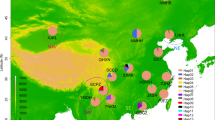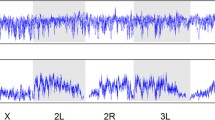Abstract
We summarize data showing that there is population structure in African populations of Drosophila from the melanogaster-simulans complex. In D. melanogaster, population structuring is found at individual loci, but is obscured by population structuring for large inversions that simultaneously affect several loci. In D. simulans, molecular polymorphism at the X-linked vermilion locus suggests that different groups of populations have been geographically isolated for some time. Invading populations are probably derived from different areas in Africa. European populations originate from an east African population that was probably not at a demographic equilibrium. The origin of the Antilles population is apparently different and is as yet unknown. In south-western France, populations from these two species undergo different population structuring at the scale of a few kilometres: D. melanogaster makes up a large panmictic population, whereas D. simulans forms a metapopulation that is divided into smaller demes.
Similar content being viewed by others
References
Alfonso, J.M., M. Hernandez, G. Padron & A.M. Gonzalez, 1985. Gametic non random association in north-west African populations of Drosophila melanogaster. Genetica 67: 3–11.
Andolfatto, P., 2001. Contrasting patterns of X-linked and autosomal nucleotide variation in Drosophila melanogaster and Drosophila simulans. Mol. Biol. Evol. 18(3): 279–290.
Andolfatto, P., J. Wall & M. Kreitman, 1999. Unusual haplotype structure at the proximal breakpoint of In(2L)t in a natural population of Drosophila melanogaster. Genetics 153: 1297–1311.
Begun, D.J. & C.F. Aquadro, 1993. African and North American populations of Drosophila melanogaster are very different at the DNA level. Nature 365: 548–550.
Bénassi, V. & M. Veuille, 1995. Comparative population structuring of molecular and allozyme variation of Drosophila melanogaster Adh between Europe, West Africa and East Africa. Genet. Res. Camb. 65: 95–103.
Bénassi, V., S. Aulard, S. Mazeau & M. Veuille, 1993. Molecular variation at the Alcohol dehydrogenase and the P6 loci in Drosophila melanogaster from West-Africa, and its relation to inversion polymorphism. Genetics 134: 789–799.
Boulétreau-Merle, J., 1992. Two paths for geographical expansion, in Advances in Regulation of Insect Reproduction, edited by B. Bennettovà, I. Gelbic & T. Soldàn. Czech Acad. Sci.
Capy, P., M. Veuille, M. Paillette, J.-M. Jallon, J. Vouidibio & J.R. David, 2000. Habitat races and sexual selection in Drosophila melanogaster: a step towards speciation in Brazzaville? Heredity 84: 468–475.
Cariou, M.-L., M. Solignac, M. Monnerot & J.R. David, 1990. Low allozyme and mtDNA variability in the island endemic species Drosophila sechellia (D. melanogaster complex). Experientia 46: 101–104.
Choudhary, M. & R. Singh, 1987. A comprehensive study of genetic variation in natural populations of Drosophila melanogaster. III. Variations in genetic structure and their causes between Drosophila melanogaster and its sibling species Drosophila simulans. Genetics 117: 697–710.
Cobb, M., M. Huet, D. Lachaise & M. Veuille, 2000. Fragmented forests, evolving flies: Molecular variation in African populations of Drosophila teissieri. Mol. Ecol. 9: 1591–1987.
Depaulis, F. & M. Veuille, 1998. Neutrality tests based on the distribution of haplotypes under an infinite site model. Mol. Biol. Evol. 15: 1788–1790.
Depaulis, F., L. Brazier & M. Veuille, 1999. Selective sweep at the Drosophila melanogaster Suppressor of Hairless locus and its association with the In(2L)t inversion polymorphism. Genetics 152: 1017–1024.
Depaulis, F., S. Mousset & M. Veuille, 2001. Haplotype tests using coalescent simulations conditional on the number of segregating sites. Mol. Biol. Evol. 18: 1136–1138.
Depaulis, F., S. Mousset & M. Veuille, 2002. Detecting selective sweeps with haplotype tests, in Selective Sweeps, edited by Nurminsky. Landes Bioscience.
Depaulis, F., S. Mousset & M. Veuille, Power of neutrality tests to detect bottlenecks and hitchhiking. J. Mol. Evol. (in press).
Dobzhansky, Th., 1965. Wild and domestic species of Drosophila, pp. 533–547 in The Genetics of Colonizing Species, edited by H.G. Baker & G. Leddyard Stebbins. Academic Press, New York and London.
Dobzhansky, Th. & S. Wright, 1941. Relations between mutation rate and accumulation of lethals in populations of Drosophila pseudoobscura. Genetics 26: 23–51.
Eanes, W.F., C. Wesley & B. Charlesworth, 1992. Accumulation of P elements in minority inversions in natural populations of Drosophila melanogaster. Genet Res. 59: 1–9.
Ferveur, J.F., M. Cobb, H. Boukella & J.M. Jallon, 1996. Worldwide variation in Drosophila melanogaster sex pheromone: behavioural effects, genetic bases and potential evolutionary consequences. Genetica 97: 73–80.
Hamblin, M.T. & M. Veuille, 1999. Population structure among African and derived populations of D. simulans: evidence for ancient subdivision and recent admixture. Genetics 153: 305–317.
Hudson, R.R. & N.L. Kaplan, 1985. Statistical properties of the number of recombination events in the history of a sample of DNA sequences. Genetics 111: 147–164.
Hutter, C.M., M.D. Schug & C.F. Aquadro, 1998. Microsatellite variation in Drosophila melanogaster and Drosophila simulans: a reciprocal test of the ascertainment bias hypothesis. Mol. Biol. Evol. 15: 1620–1636.
Inoue, Y. & T.K. Watanabe, 1980. Inversion polymorphism in some African, New Guinean and Philippine populations of D. melanogaster. Ann. Rep. Natl. Inst. Genet. Jpn. 30: 88.
Kauer, M., B. Zangerl, D. Dieringer & C. Schlötterer, 2002. Chromosomal patterns of microsatellite variability contrast sharply in African and non-African populations of Drosophila melanogaster. Genetics 160: 247–256.
Kliman, R.M., P. Andolfatto, J.A. Coyne, F. Depaulis, M. Kreitman, A.J. Berry, J. McCarter, J. Wakeley & J. Hey, 2000. The population genetics of the origin and divergence of the Drosophila simulans complex species. Genetics 156: 1913–1931.
Kreitman, M., 1983. Nucleotide polymorphism at the alcohol dehydrogenase gene region of Drosophila melanogaster. Nature 304: 412–417.
Kreitman, M. & R. Hudson, 1991. Inferring the evolutionary histories of the Adh and Adh-dup loci in Drosophila melanogaster from patterns of polymorphism and divergence. Genetics 127: 565–582.
Kruglyak, S., R.T. Durrett, M.D. Schug & C.F. Aquadro, 1998. Equilibrium distributions of microsatellite repeat length resulting from a balance between slippage events and point mutations. Proc. Natl. Acad. Sci. USA 95(18): 10774–10778.
Lachaise, D., F. Lemeunier & M. Veuille, 1981. Clinal variation in male genitalia in Drosophila teissieri Tsacas. Am. Nat. 117: 600–608.
Lachaise, D., M.-L. Cariou, J.R. David, F. Lemeunier & L. Tsacas, 1988. Historical biogeography of the Drosophila melanogaster species subgroup. Evol. Biol. 22: 159–225.
Lemeunier, F. & S. Aulard, 1992. Inversion polymorphism in Drosophila melanogaster, pp. 339–405 in Drosophila Inversion Polymorphism, edited by C.B. Krimbas & J.R. Powell. CRC Press, Cleveland.
Lemeunier, F., S. Aulard, V. Bénassi & M. Veuille, 1994. Scientific correspondence: fruitfly origins. Nature 371: 25.
Lewontin, R.C., J.A. Moore, W.B. Provine & B. Wallace, 1981. Dobzhansky's Genetics of Natural Populations, I-XLIII. Columbia University Press, New York.
Luyten, I., 1982. Variation intraspécifique et interspécifique des hydrocarbures cuticulaires chez Drosophila simulans et des espèces affines. C. R. Acad. Sci. Paris, Sci. Vie. 295: 733–736.
Michalakis, Y. & M. Veuille, 1996. Length variation of CAG/CAA trinucleotide repeats in natural populations of Drosophila melanogaster and its relation to the recombination rate. Genetics 143: 1713–1725.
Mousset, S. & N. Derome, Molecular polymorphism in Drosophila melanogaster and D. simulans: what have we learnt from recent studies? Genetica (in press).
Mousset, S., L. Brazier, M.-L. Cariou, F. Chartois, F. Depaulis & M. Veuille, Evidence of multiple selective sweep events in the Drosophila melanogaster genome. Genetics (in press).
Nei, M., 1975. Molecular Population Genetics. North-Holland, Amsterdam, Oxford.
Nei, M., 1987. Molecular Evolutionary Genetics. Columbia University Press, New York.
Newfeld, S.J., A.T. Schmid and B. Yedvobnick, 1993. Homopolymer length variation in the Drosophila gene mastermind. J.Mol. Evol. 37: 483–495.
Newfeld, S.J., H. Tachida & B. Yedvobnick, 1994. Drive-selection equilibrium: homopolymer evolution in the Drosophila gene mastermind. J. Mol. Evol. 38: 637–641.
Petrov, D.A., T.A. Sangster, J.S. Johnston, D.L. Hartl & K.L. Shaw, 2000. Evidence for DNA loss as a determinant of genome size. Science 287: 1060–1062.
Raymond, M. & F. Rousset, 1995. Genepop (version 1.2): population genetics software for exact tests and ecumenism. J. Hered. 86: 248–249.
Sawyer, S.A. & D.L. Hartl, 1992. Population genetics of polymorphism and divergence. Genetics 132: 1161–1176.
Schlötterer, C., R. Ritter, B. Harr & G. Brem, 1998. High mutation rate of a long microsatellite allele in Drosophila melanogaster provides evidence for allele-specific mutation rates. Mol. Biol. Evol. 15(10): 1269–1274.
Singh, R., 1989. Population genetics and evolution of species related to Drosophila melanogaster. Ann. Rev. Genet. 23: 425–453.
Veuille, M., V. Bénassi, S. Aulard & F. Depaulis, 1998. Allele-specific population structure of Drosophila melanogaster Alcohol dehydrogenase at the molecular level. Genetics 149: 971–981.
Vouidibio, J., P. Capy, D. Defaye, E. Pla, J. Sandrin, A. Csink & J.R. David, 1989. Short-range genetic structure of Drosophila melanogaster populations in an Afrotropical urban area and its significance. Proc. Natl. Acad. Sci. USA 86: 8442–8446.
Waples, R.S., 1989. A generalized approach for estimating effective population size from temporal changes in allele frequency. Genetics 121: 379–392.
Watanabe, T.K., Y. Inoue & M. Watada, 1984. Adaptation of Drosophila simulans in Japan. Jpn. J. Genet. 59: 225–235.
Wright, S., 1951. The genetical structure of populations. Ann. Eugen. 15: 323–354.
Zohary, D. & M. Hopf, 2000. Domestication of Plants in the Old World. Oxford University Press, Oxford, 3rd edn.
Author information
Authors and Affiliations
Rights and permissions
About this article
Cite this article
Veuille, M., Baudry, E., Cobb, M. et al. Historicity and the Population Genetics of Drosophila Melanogaster and D. Simulans . Genetica 120, 61–70 (2004). https://doi.org/10.1023/B:GENE.0000017630.69020.32
Issue Date:
DOI: https://doi.org/10.1023/B:GENE.0000017630.69020.32




